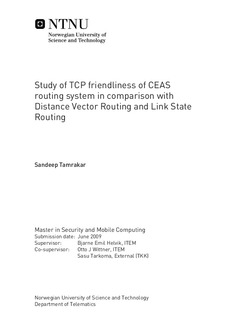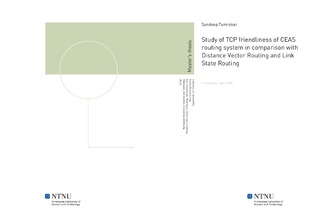| dc.contributor.advisor | Helvik, Bjarne Emil | nb_NO |
| dc.contributor.advisor | Wittner, Otto J | nb_NO |
| dc.contributor.advisor | Tarkoma, Sasu | nb_NO |
| dc.contributor.author | Tamrakar, Sandeep | nb_NO |
| dc.date.accessioned | 2014-12-19T14:12:36Z | |
| dc.date.available | 2014-12-19T14:12:36Z | |
| dc.date.created | 2010-09-03 | nb_NO |
| dc.date.issued | 2009 | nb_NO |
| dc.identifier | 347854 | nb_NO |
| dc.identifier | ntnudaim:4710 | nb_NO |
| dc.identifier.uri | http://hdl.handle.net/11250/261850 | |
| dc.description.abstract | With the continuous development of the Internet technologies new routing requirements have surfaced. In response, several adaptive, stochastic routing algorithms have been purposed. The Cross Entropy Ant System (CEAS) is an adaptive, robust and distributed routing and management system based on the swarm intelligence. Several prototype implementations and enhancements have been made on this system, however the level of TCP friendliness the CEAS may provide is yet an important issue. In order to investigate the level of TCP friendliness, the behavior of the CEAS system during different network dynamics needs to be understood. For this reason, the behavior of the CEAS system under different network event and its corresponding effects on TCP performance is examined first using a simple network. Later the level of TCP performance is measured on complex networks. Also the load sharing capabilities of the CEAS system is investigated the efficiency of the system to manage and update according to the network load. Additionally the results are compared against the results obtained from the standard Link State Routing protocol and the Distance Vector Routing protocol under similar conditions. In this work, we find that the update process in response to the change in network dynamics is slower on CEAS compared to the other systems. However, the update process speeds up with the increase in the ant rates. During such period the use of multiple path reduces the TCP performance. We also find that large amount of packets loop around some links during link failures. Such looping reduces the TCP performance significantly. However, implementing previous hop memory technique removes such loops and also help TCP resume transmission immediately after the link failure. Compare to the LSRP and the DVR, we find that CEAS manages network resources more efficiently to produce higher TCP performance. We find that the CEAS diverts the data traffic on the basis of the quality of the path rather than the length of the path. We also find that the CEAS system handles multiple TCP stream independently with equal priority. But the smaller transition delay on the ants compared to the data packet reduces the TCP performance to some extent. However, forcing the ants to experience longer queuing delay according to the traffic load improves the TCP performance as well as helps CEAS update more accurately. | nb_NO |
| dc.language | eng | nb_NO |
| dc.publisher | Institutt for telematikk | nb_NO |
| dc.subject | ntnudaim | no_NO |
| dc.subject | MSSECMOB Master in Security and Mobile Computing | no_NO |
| dc.subject | Information security | no_NO |
| dc.title | Study of TCP friendliness of CEAS routing system in comparison with Distance Vector Routing and Link State Routing | nb_NO |
| dc.type | Master thesis | nb_NO |
| dc.source.pagenumber | 111 | nb_NO |
| dc.contributor.department | Norges teknisk-naturvitenskapelige universitet, Fakultet for informasjonsteknologi, matematikk og elektroteknikk, Institutt for telematikk | nb_NO |

